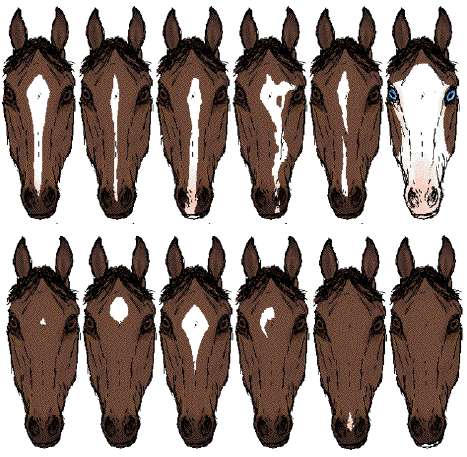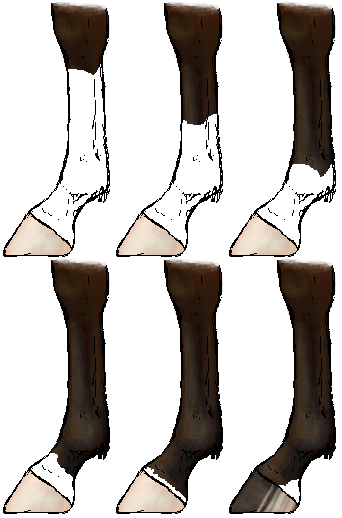 I'm going to cover two things in this post: first up, white markings.
I'm going to cover two things in this post: first up, white markings.Many horses with a dark base coat colour (i.e. the ones we were talking about in the previous post) have white markings on the face, as well as one or more white 'socks'.
 Facial markings range widely from almost none to the whole face - they're actually areas with different colour skin and hair pignment - note, for example, that when the white extends all the way to the nose, the underlying skin colour is pink, not dark.
Facial markings range widely from almost none to the whole face - they're actually areas with different colour skin and hair pignment - note, for example, that when the white extends all the way to the nose, the underlying skin colour is pink, not dark.Leg markings can extend as far as the knee, or as little as just above the hoof. Note that the hoof colour on a leg with white markings is going to be a shade ranging from flesh to pale khaki, not dark.
[Both images in the public domain, via Wikipedia's article on horse markings]
Ok. So that's white markings. What about white horses?
To begin with, a lot of the white horses you see aren't white. They're actually greys - even the famous Lipizaners (of "White Horses" fame, if you had the same schoolboy crush I did!) are grey, not white. Grey is produced by the grey gene, G or g.
- G means the horse's coat will tend to go grey/white with age, much like a human's hair.
- g means it won't.
Again, simples! Grey horses start out one of the principal colours as determined by their A/E genes, and as they age, they go greyer, until, eventually, they can end up white. The skin colour, however, remains dark (except under markings that were white at birth), so you can often tell whether a white horse is genetically a grey by looking at the shading round mouth and eyes, which will be dark. That is, if its mane and tail don't give it away by greying at a different rate to the coat, which can happen.
 |
| A 'bloody shouldered' grey Picture by Kumana @ Wild Equines |
The grey colour goes through a stage of being a mix of dark and light hairs, leading to some interesting colours:
- Various shades of grey
- Dappled, where the intermixing of dark and light isn't uniform
- 'Flea-bitten', where a red/brown base colour starts to re-emerge after the horse has become white, leading to a horse with a white coat with speckles of red throughout.
A rather spectacular variant of flea-bitten is known as 'bloody-shouldered', where the red is highly visible, usually on the shoulders.
There are a number of other genes that produce 'white' horses. One of the most common is the 'Dominant White' gene, W and w:
- W is dominant, and produces a genuinely white from birth horse irrespective of the A and E genes - this can be distinguished by the skin around the mouth etc being pinkish, not dark.
- w doesn't - normal coat colouration genes take precedence.
Pure white horses are Ww, because the WW combination is fatal - an embryo with WW is reabsorbed and never goes to term.
There are other genes which can produce the appearance of white, but I'll cover those in a later article.
Next, duns and roans.
No comments:
Post a Comment
Views and opinions expressed here are those of the commenter, not mine. I reserve the right to delete comments if I consider them unacceptable. Unfortunately due to persistent spam from one source, I've been forced to turn on captchas for comments.
Comments on posts older than 7 days will go into a moderation queue.